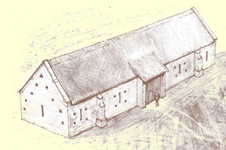| HOME News Terminology Contact |


Green oak


It is often considered that Green oak is freshly-felled oak, but this not strictly the case.
Wood is comprised of 2 sorts of water, ‘free’ or ‘mobile’ water which sits in the cell cavities, and ‘bound’ or ‘immobile’ water that is contained within the cell walls. Oak that is newly felled will be high in both types but over time will dry out due to evaporation, and usually shrink and crack. ‘Fibre saturation point’ is reached when the timber has lost all its free water and only retains its bound water. Oak will have a moisture content of approximately 30 per cent at its fibre saturation point. Below this point, the timber is losing the bound water and can be termed ‘dry’ or ‘partly dry’. It is at this point the timber may distort and crack. To further dry the oak out a kiln is generally used.
Green oak therefore is timber that has a moisture content greater than its fibre saturation point.
Green oak is cheaper than kiln dried oak but requires the work of a skillfull craftsman, as the timber will often distort and even crack over time as the natural drying process continues. The cracks and distorations however, very often, give the wood a characterful quality, or aged look, which is often desirable in restoration projects.









